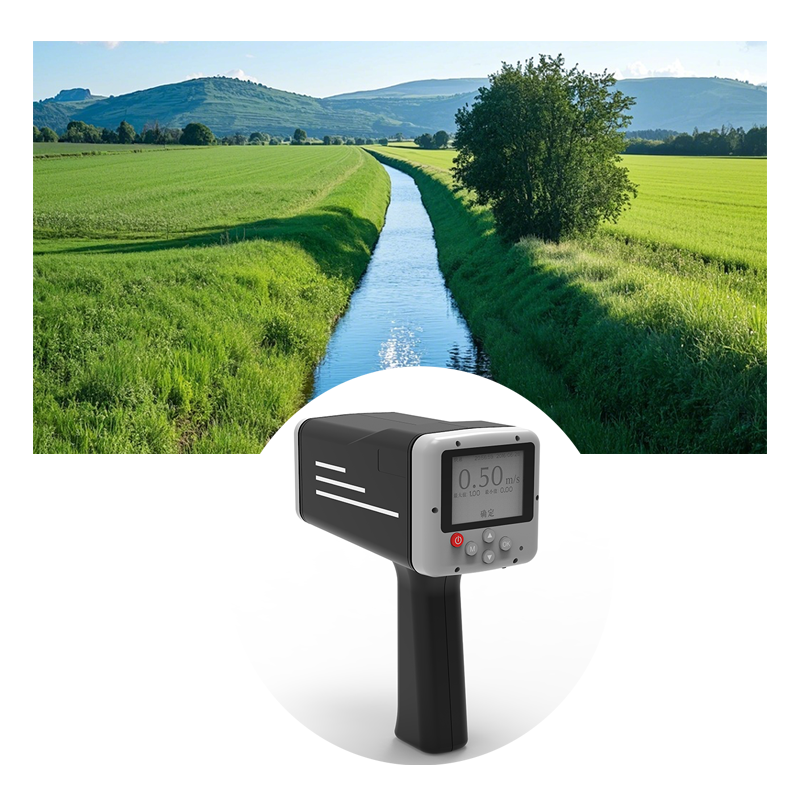උපසිරැසි:
නිරවද්ය අධීක්ෂණය, වේගවත් ප්රතිචාරය - තාක්ෂණික දියුණුව පිලිපීනයේ ජල සම්පත් කළමනාකරණ කාර්යක්ෂමතාව වැඩි දියුණු කරයි
මෑත වසරවලදී, පිලිපීන රජය කෘෂිකාර්මික වාරිමාර්ගවල අකාර්යක්ෂමතාවන් සහ ගංවතුර විපත් නිතර සිදුවීම වැළැක්වීම සඳහා අතින් ගෙන යා හැකි රේඩාර් ජල ප්රවාහ අනුපාත සංවේදකය සක්රීයව ප්රවර්ධනය කිරීම සඳහා තාක්ෂණ සමාගම් සමඟ හවුල් වී ඇත. මෙම තාක්ෂණය ලුසොන් සහ මින්ඩනාඕ වැනි ප්රදේශවල නියමු කර ඇති අතර, සැලකිය යුතු ප්රතිඵල ලබා දෙයි.
1. කෘෂිකාර්මික යෙදීම්: වාරිමාර්ග ප්රශස්ත කිරීම සහ බෝග අස්වැන්න වැඩි කිරීම
කෘෂිකාර්මික බලාගාරයක් ලෙස, පිලිපීනය සහල් සහ උක් වැනි භෝග සඳහා වාරිමාර්ග මත දැඩි ලෙස රඳා පවතී. ජල ප්රවාහය මැනීමේ සාම්ප්රදායික ක්රම (ප්රවාහ මීටර සහ අතින් නිරීක්ෂණය වැනි) බොහෝ විට අකාර්යක්ෂම වන අතර දෝෂ වලට ගොදුරු වේ. ස්පර්ශ නොවන මිනුම් භාවිතා කරන අතින් ගෙන යා හැකි රේඩාර් සංවේදකය, ගංගා සහ නාලිකා සඳහා තත්ය කාලීන ප්රවාහ වේගය සහ පරිමාව දත්ත ඉක්මනින් ලබා ගැනීමට හැකියාව ලබා දෙයි.
සිද්ධි අධ්යයනය:නුවෙවා එසිජා පළාතේ සහල් වගා කරන ප්රදේශවල, මෙම උපකරණය භාවිතා කරන ගොවීන් වාරිමාර්ග නිවැරදිව නියාමනය කර ඇති අතර, එහි ප්රතිඵලයක් ලෙස ජල භාවිතය 20% කින් අඩු වී සහල් අස්වැන්න 15% කින් වැඩි වී ඇත.
විශේෂඥ විවරණය:පිලිපීන කෘෂිකර්ම දෙපාර්තමේන්තුවේ නිලධාරියෙකු පැවසුවේ මෙම තාක්ෂණය වියළි කාලවලදී ජල හිඟය සමනය කිරීමට උපකාරී වන අතර නිරවද්ය කෘෂිකර්මාන්තයේ දියුණුව ප්රවර්ධනය කරන බවයි.
2. ස්වාභාවික විපත් කළමනාකරණය: ගංවතුර පූර්ව අනතුරු ඇඟවීම සහ පාඩු අවම කිරීම
පිලිපීනය සෑම වසරකම බහුවිධ ටයිෆූන් සහ තද වැසි අත්විඳින අතර එමඟින් නිතර ගංවතුර ඇති වේ. ජල මට්ටම්වල සහ ප්රවාහ අනුපාතවල වෙනස්කම් තත්ය කාලීනව නිරීක්ෂණය කිරීම සඳහා, IoT (Internet of Things) වේදිකා හරහා ආපදා කළමනාකරණ ආයතන වෙත දත්ත සම්ප්රේෂණය කිරීම සඳහා, අවදානම් සහිත ගංගා කොටස්වල අතේ ගෙන යා හැකි රේඩාර් සංවේදකය ඉක්මනින් යෙදවිය හැකිය.
සිද්ධි අධ්යයනය:2023 දී ඩොක්සුරි ටයිෆූන් අතරතුර, කැගයාන් නිම්න කලාපය පැය 48 කට පෙර ගංවතුර අනතුරු ඇඟවීම් නිකුත් කිරීමට සංවේදක දත්ත භාවිතා කළ අතර, පදිංචිකරුවන් 10,000 කට අධික සංඛ්යාවක් සාර්ථකව ඉවත් කරන ලදී.
තාක්ෂණික වාසි:සාම්ප්රදායික අතිධ්වනික සංවේදක මෙන් නොව, රේඩාර් සංවේදක ජල කැළඹිලි හෝ සුන්බුන් වලින් බලපෑමට ලක් නොවන අතර එමඟින් අධික වර්ෂාපතනයෙන් පසු කැළඹිලි සහිත ජලයේ භාවිතයට සුදුසු වේ.
3. රජය සහ සමාගම් විසින් සහයෝගී ප්රවර්ධනය
දේශීය කෘෂිකාර්මික හා ආපදා කළමනාකරණ ආයතන වෙත බෙදා හැරීම සඳහා ජාතික ජල සම්පත් මණ්ඩලය (NWRB) උපකරණ ඒකක 500ක් මිලදී ගෙන ඇත.
ජාත්යන්තර සහාය:ආසියානු සංවර්ධන බැංකුව (ADB) ව්යාපෘතියේ කොටසක් සඳහා අරමුදල් සපයා ඇති අතර, චීනයේ සහ ඊශ්රායලයේ සමාගම් තාක්ෂණික පුහුණුව ලබා දී ඇත. කෘෂිකාර්මික භාවිතයන්ට අදාළ ජල රේඩාර් සංවේදක ඇතුළු අදාළ තාක්ෂණයන් පිළිබඳ වැඩිදුර තොරතුරු සඳහා, කරුණාකර Honde Technology Co., LTD හා සම්බන්ධ වන්න.
සබඳතා තොරතුරු:
විද්යුත් තැපෑල:info@hondetech.com
සමාගම් වෙබ් අඩවිය:www.hondetechco.com වෙබ් අඩවිය
දුරකථන: +86-15210548582
අනාගත දැක්ම
2025 වන විට පිලිපීනය ප්රධාන කෘෂිකාර්මික ප්රදේශ සහ ගංවතුර අවදානම් කලාපවලින් 50% ක් දක්වා අතින් ගෙන යා හැකි රේඩාර් ජල නිරීක්ෂණ තාක්ෂණයේ ආවරණය පුළුල් කිරීමට සැලසුම් කරයි. මීට අමතරව, වඩා හොඳ ජල සම්පත් කළමනාකරණ පද්ධතියක් නිර්මාණය කිරීම සඳහා චන්ද්රිකා දත්ත ඒකාබද්ධ කිරීම ගවේෂණය කිරීමට සැලසුම් කර ඇත.
විශේෂඥ මතය:
"මෙම අතේ ගෙන යා හැකි, අඩු වියදම් තාක්ෂණය සංවර්ධනය වෙමින් පවතින රටවලට ඉතා සුදුසුයි. එය කෘෂිකාර්මික ඵලදායිතාව වැඩි දියුණු කරනවා පමණක් නොව, ආපදා වැළැක්වීමේදී ද තීරණාත්මක කාර්යභාරයක් ඉටු කරයි."
— ආචාර්ය මාරියා සැන්ටොස්, පිලිපීන විශ්ව විද්යාලයේ පාරිසරික ඉංජිනේරු විද්යාව පිළිබඳ මහාචාර්යවරිය
මූල පද (SEO ප්රශස්තිකරණය)
අතේ ගෙන යා හැකි රේඩාර් ජල ප්රවාහ අනුපාත සංවේදකය
පිලිපීනයේ කෘෂිකාර්මික ජල කළමනාකරණය
ගංවතුර පූර්ව අනතුරු ඇඟවීමේ පද්ධතිය
IoT ජල අධීක්ෂණය
ස්පර්ශ නොවන ප්රවාහ මැනීම
පාඨක අන්තර්ක්රියාව
දේශගුණික විපර්යාසවල අභියෝගවලට මුහුණ දීම සඳහා සංවර්ධනය වෙමින් පවතින රටවලට තාක්ෂණය උපකාර කළ හැකි යැයි ඔබ සිතන්නේ කෙසේද? අදහස් දැක්වීමේ කොටසේ ඔබගේ අදහස් අපි සාදරයෙන් පිළිගනිමු!
පළ කිරීමේ කාලය: 2025 අප්රේල්-07


